Mayors of Allentown, Pennsylvania
| Edwin E. "Ed" Pawlowski | |
|---|---|
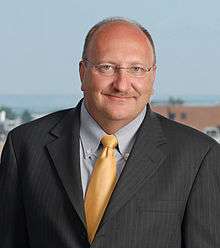 | |
| Forty-first Mayor of Allentown, Pennsylvania | |
|
Assumed office January 3, 2006 |
The city of Allentown, Pennsylvania was founded in 1762 as – Northampton Town by William Allen, a wealthy shipping merchant. During its first fifty years of existence, Northampton Town was a small unincorporated settlement, consisting of a few homes, stores and taverns.
Political origins
After reaching a population of over 700 residents in the 1810 United States Census, the Commonwealth of Pennsylvania gave Northampton Town a legal existence on 18 March 1811 by incorporating it as the – Borough of Northampton, in Northampton County. Previous to this Northampton Town had community leaders, and with its incorporation as a Borough, the first local politicians were born. The first Borough election was held at the tavern of George Savitz, a tavern-keeper who owned the Square and Compass, an inn located at the northeast corner of 7th and Hamilton Streets.[1]
Peter Rhodes was chosen as the first Burgess; George Rhoads as the town clerk; John F. Rhue as the High Constable, and a town council was established as the first civic legislature. Peter Rhodes was a prominent citizen and shopkeeper who served on the Committee for Public Safety in Northampton during the Revolutionary War. The first business of the Borough government was to order cows to seek other pastures other than the public streets. An action which led many of its citizens to believe they were better off when it was plain Northampton Town, before it became a Borough.[1]
In 1812, Lehigh County was formed by partitioning a section of Northampton County, and Northampton was designated as its county seat. Frederick Eckert was elected as the second Burgess. George Graff was elected Burgess in 1813, however records of elections in Northampton have been lost from the period 1815–1830. On 16 April 1836, an act of the Pennsylvania Legislature changed the name of the community from Nortampton to – Allentown, and John P. Rhue was Burgess. During its existence as a Borough, Northampton/Allentown had a total of forty-seven annual municipal elections. A Burgess was elected each year, the most prominent was John J. Krauss, being elected five times in succession from 1830 to 1835. Other known Burgesses of the town were Samuel Runk (1839–1849); Robert E. Wright (1845), and Peter Wycoff (1846).[1] In 1866, William Kern was elected burgess over Thomas Mohr by a vote of 974 to 881, Kern being the last Burgess of Allentown[2]
City of Allentown Mayors
The first step in changing the local government in Allentown began in January, 1866 when the various ward districts called for a consolidation of the various schools into one school district as a central authority. This led to other consolidations of the various wards into centralized police departments, a treasurer and also a consolidated council. Within a year, legislation was proposed ianln Harrisburg by Lehigh County State Senator George P. Shall to incorporate Allentown as a city. The legislation was passed by the Pennsylvania Legislature on 12 March 1867 creating the City of Allentown, and the first city election was held on 1 May.[2] The first city charter specified a Bicameral form of government, consisting of a Select Council of fourteen (including the Mayor) and a Common Council of twenty-eight members.[2]
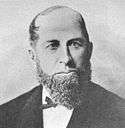
- 1 – Samuel McHose (1867–1869, Republican)
- First mayor under the first Allentown City Charter, sworn into office on 19 May 1867. Born 16 February 1816 in Lower Saucon, Northampton County, the son of Isaac McHose. Founded the Allentown Fire Brick Works in 1854 at Front and Gordon streets. This company, later renamed McHose and Ritter, was in business for 25 years. Strong anti-slavery activist during the 1850s, was a delegate to the Republican Convention in Chicago that nominated Abraham Lincoln in 1860. Between 1854 and 1873, McHose, an industrial contractor, "built nearly every iron furnace in the Lehigh Valley," notes Charles R. Roberts in his 1914 Anniversary History of Lehigh County.[3] As mayor, McHose Encouraged industrial development of city after the Civil War. After term of mayor ended, heavily invested in the Hope Rolling Mills, which made railroad rails. Became City Councilmen for the Fifth Ward in 1884. Died 21 April 1893.[1][4]
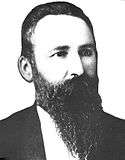
- 2, 5 – Col. Tilghman H. Good (1869–1873, 1874–1876, Democrat)
- Born 6 October 1830 in Whitehall Township. Was first mayor of Allentown to serve two separate terms. Served in Pennsylvania Militia prior to the Civil War, organized First Pennsylvania Volunteers in 1861. Later organized 47th Pennsylvania Infantry during Civil War, commanded regiment for three years. Became hotel owner of prominent Hotel Allen, later moved to Reading after 1885, died 18 July 1887 in Reading[1][5]

- 3 – Dr. Theodore C. Yeager (1873–1874)
- Died in office, 14 January 1874
- First mayor born in Northampton (Allentown) on 1 April 1838, son of a Clergyman. Studied medicine and graduated as a physician.[1][6]
- 4 – Herman Schuon (1874–1876)
- Born in Württemberg (southwest Germany), 22 Feb 1835. Civil War veteran. Appointed mayor by Select Council. Was president of Select Council and was appointed by virtue of his office. Did not run for mayor in 1876. Died 10 October 1912 in Allentown.[1]
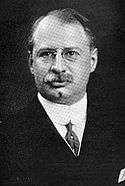
- 6 – Col. Edward B. Young (1876–1878, Republican)
- Known as the "Centennial Mayor". Popular mayor at the time, former chief magistrate. Born in Allentown on 6 September 1836, attended school at the "Allentown Academy" then learned watchmaking in Bellefonte. Returned to Allentown in 1855, going into business with the Barber, Young and Company hardware company. Served in the 49th Pennsylvania Infantry during the Civil War, fought at Gettysburg then became head of Allentown Steam Heating and Power Company; took an active part in the organization of the Lehigh Valley Traction Company; director of Lehigh Valley Trust Company. Died in on 30 December 1878, shortly after leaving office.[1][7]
- 7 – Dr. Alfred J. Martin (1878–1880, Democrat)
- Born 1837 in Allentown. Assumed office in April 1878, was medical doctor (UoP 1857). He appointed former mayor Tilghman H. Good as chief of police. Encouraged business growth and also supported health issues of Civil War veterans and their families providing them medical care.[1]
- 8 – Dr. Edwin G. Martin (1880–1884, Democrat)
- Brother of Alfred J. Martin, born 1836, also medical doctor (UoP 1856). Served two terms, continued the progressive initiatives of his brother during his term. Stepped down voluntarily in 1884 and returned to medical practice with his brother.[1]
- 9 – Edwin S. Shimer (1884–1886, Republican)
- Born in Shimersville in 1832. Graduate of Lutheran Seminary in Stewadsville, NJ, became merchant with Grim & Renninger (607 Hamilton Street). Saw expansion of the city in population and size, being extended west to 15th Street. Served single term, stepped down voluntarily in 1886.[1]
- 10 – Walter K. Rhue (1886–1888, Democrat)
- Born in Allentown in 1843. Printer by trade, worked at the Allentown Democrat newspaper. Civil War veteran, seeing combat at Gettysburg, Antietam and South Mountain. Headed Allentown Fire Department as chief engineer prior to election as mayor. Also served single term, stepping down in 1888.[1]
- 11, 13 – Henry W. Alliston (1888–1890, 1893–1896, Republican)
- Allentown native, industrialist, secretary and treasurer of the Allentown Rolling Mills. Streetcar service changed from horse-driven to electric powered in downtown, expansion of business district west to 12th Street. Served several terms as mayor during the late 1880s to late 1890s, elected twice, and filling the unexpired term of Col Samuel Lehr in 1896.[2]
- 12 – Col. Samuel D. Lehr (1890–1893, Republican)
- Born in Allentown, 1838, Civil War veteran. Operated tailor and dry goods store in Allentown before entering politics in the 1880s. Saw construction of new Allentown Lehigh Valley and Central Railroad of New Jersey passenger terminals. Resigned in 1893.[2]

- 14, 16, 25 – Fred Ewing Lewis (1896–1899, 1902–1905, 1932–1936, Republican)
- First three-term mayor of Allentown. Born in Allentown (1865), graduated from Muhlenberg College, he studied law and was admitted into the Pennsylvania Bar in 1888. He established a practice in Allentown, Pennsylvania, where he served as a bank president. First elected Mayor in 1896, Defeated by James L. Shadt in 1899, was re-elected in 1902 before stepping down in 1905. He was elected as a Republican to represent Pennsylvania as an At-Large delegate in the United States House of Representatives, serving a single term from March 4, 1913 to March 3, 1915. He returned to Allentown, engaging in his law practice and in banking. He organized and was president of the Merchants’ National Bank and was president of the Dime Savings & Trust Co. in Allentown. Served a third term during the depression years (1932–1936) then lost to Malcom T. Gross (Gross won a 4th Term). Remained prominent in city affairs until his death in 1949.[8]
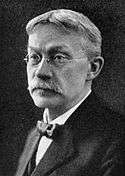
- 15 – James L. Schaadt (1899–1902, Republican)
- Born in 1856, attended Allentown public schools, graduating from Muhlenberg College in 1874. Lawyer and teacher, admitted to PA Bar in 1878. Author of history of the Allen Infantry, one of five Pennsylvania companies (the "First Defenders") that went to Washington DC in April 1861 to defend the nation's capital. Mayor of Allentown during construction and dedication of the Soldier's and Sailor's Civil War monument at Center Square (1899). Mayor during 1900 turn of the century, expanded telephone and electrification service to center city residents. After his term as mayor, became a trustee for Allentown Hospital and a president of Associated Charities (later United Way).[7]
- 17 – Dr. Albert J. Yost (1905–1907, Democrat)
- Died in office, 16 April 1907.
- Notable legacy is the development with Harry Trexler of West Park, first public park in Allentown. In 1904, a small boy playing baseball on the empty lot with friends sent a ball through the window of a Turner Street residence. He was taken downtown to the mayor's office by a policeman and was described as "very much frightened and dirty." Mayor Lewis was very much upset by the action of the officer and asked what could be done to prevent similar proceedings," Bascom wrote. He suggested to Yost, who headed up the Water Bureau give up the space and turn it over to a Parks Department, made up of Yost, himself and city Treasurer Al Reichenbach.[9]
- 18 – Dr. Charles D. Schaeffer (1907–1908, Democrat)
- Appointed mayor by Select Council. Interim mayor, most noted for development of Allentown Hospital Nursing College and plans for Allentown Water Works to improve public water supply that was contaminated by cesspools. Later became head surgeon at Allentown Osteopathic Hospital[2][7]
- 19 – Henry G. Styles (1908, Democrat)
- Died in office, 8 November 1908 after 10 months as mayor.[2]
- 20 – Dr. Herbert H. Herbst (1908–1909, Democrat)
- Born 22 May 1858 in Allentown. Appointed mayor by Select Council. Implemented plans for Allentown Water Works, also expanded public school system. Fifth Ward Elementary school later named after him, "Herbst School". Died 20 September 1911.[2]
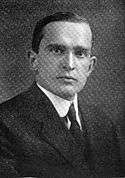
- 21 – Charles O. Hunsicker (1909–1911, Republican)
- Born 1878 in Allentown. Attorney. Attended Allentown High School, and in 1896 was graduated from the Mercersburg Academy. He pursued his studies at Franklin and Marshall College, from which institution he was graduated in 1900. In 1903 he finished his studies at the University of Pennsylvania Law School. Youngest mayor of Allentown, being elected in 1909 at age of 31. Redeveloped a large portion of the West End, Allentown's residential section, and built hundreds of homes throughout the city. Hunsicker Elementary School named after him. Died 1941 in Allentown.[2][7]
- 22 – Charles W. Rinn (1912–1915, Democrat)
- Born 6 October 1869 in Allentown. Saw Allentown given Pennsylvania Third-Class City status (1913), leading to adoption of new city charter. First mayor under commission form of government (1914) under which the mayor and four elected councilmen had served as full-time department heads. Born in Easton in 1868, family moved to Allentown when he was six. Father was a printer, Rinn apprenticed in his father's shop. Later operated a butcher shop. Defeated Fred Lewis in 1911 general election, served one term as mayor, by all accounts honorably. Died 7 October 1920.[10] Died 1920.
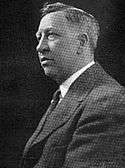
- 23 – Alfred L. Reichenbach (1915–1919, Non-Partisan)
- Born in Allentown in 1860. Mayor during World War I. Born in 1860. Longtime (24 years) treasurer of Allentown. Responsible for $80,000 nurses home across the street from the Allentown Hospital built in 1914.[7] Also noted for traveling to Europe in early 1900s and seeing beautiful hanging gardens and floral lamp posts in Paris and in some cities in Germany. He was also an amateur horticulturist and enjoyed all varieties of flowers and anyone visiting the mayor's office during his tenure would find vases of flowers for all seasons on his desk and tables. In fact, it was he who had floral boxes planted outside the mayor's window so he, and his fellow citizens, could enjoy seasonal floral designs. He believed that it would be a good way to beautify the downtown shopping district and encouraged the City Council with idea of purchasing the floral lamp posts during the renovations of Hamilton Street in 1916, taking down overhead electrical and telephone lines and moving them underground. Died in 1920.[2]
- 24, 26 – Malcolm W. Gross (1920–1932, 1936–1940, Democrat)
- Born 1872 in Allentown. Malcolm W. Gross was mayor of Allentown for four terms (16 years) during the 1920s and 1930s. He worked closely with General Harry Trexler, who served on the city Planning Commission during that time, to create Allentown's park system. Developed Allentown Rose Garden (1928), purchased land for Little Lehigh Parkway (1928), and established Cedar Creek Park Trexler Memorial Park and Union Terrace in the early 1930s. Saw construction of Tilghman Street Bridge, Americus Hotel and Pennsylvania Power & Light Buildings in Central Business District. Died in 1944.[2]
- 27 – George F. Erich (1940–1944, Democrat)
- Born 21 October 1899 in Laury's Station. World War II mayor of Allentown. Encouraged large number of metal scrap drives, coordinated Draft Boards and War Bond sales and parades. Allentown during Mayor Erich's term saw several major defense contracts come to the city, construction of Convair Field (Now Queen City Airport) for Consolidated Aircraft Vultee aircraft production. Large numbers of wartime houses and development of Lehigh Street shopping area. Expansion of Mack Truck in SW Allentown. Use of Airport for Naval ROTC pilot training. Lehigh Structural Steel expanded for wartime needs.[2]
- 28, 30 – Brighton C. Diefenderfer (1944–1948, 1952–1956, Republican)
- Both 1 January 1902 in Allentown. Diefenderfer and Donald Hock exchanged terms as Mayor during the Post World War II era and during the 1950s. Allentown-Bethlehem-Easton (ABE) Airport new terminal opened in 1948. Visitors to Allentown included President Eisenhower and General Douglas MacArthur. Allentown School District Stadium opened in 1948. The last Lehigh Valley Transit streetcars ended service in 1953, being replaced by buses. Diefenderfer managed the transition from the Wartime industrial boom into the postwar peacetime prosperity, Hamilton Street being turned into a one way eastbound street between 10th and 6th streets. The first Cold War air raid drills in Allentown were carried out and Civil Defense shelters were established in Allentown Public Schools during the mid–1950s. Both under Diefendurfer and Donald Hock, industrial development of Southwest Allentown expanded greatly, with Willard Batteries, Mack Truck, Downyflake Foods, L.F. Grammes Company, Sarco Manufacturing and Royal Crown Bottling establishing manufacturing plants in the SW part of the city. Died 8 April 1982.[2]
- 29, 31 – Donald V. Hock (1948–1952, 1956–1960, Democrat)
- Born 5 January 1910 in Allentown. During the postwar era, Hock acquired Convair Field from the War Assets Administration and developed it into Queen City Airport. In 1957, it was Hock's idea to expand Allentown's St. Patrick's Day parade from a parochial observance to a citywide spectacle embracing the theme of brotherhood. After the first citywide parade proved a success, Hock wrote a letter stating: "Today democracy really marched down Hamilton Street." The renovation of the Soldiers & Sailor's Monument was carried out, replacing the "Goddess of Liberty" Statue with a newer version. The Hamilton Street Bridge across the Lehigh River was replaced. Dieruff High School opened in 1958, Allen High School Linden Street Wing opened in 1957. South Mountain Jr. High School opened 1960. Died February 1986.[2]
- 32 – John T. Gross (1960–1964, Democrat)
- Born 9 November 1901. Son of longtime former mayor Malcom W. Gross, accomplishments during John T. Gross's term was the construction of the new Lehigh County Court House (1962) and Allentown City Hall and Police Department (1962). Both Vice-President Richard Nixon and Senator John Kennedy led large campaign rallies during the 1960 Presidential Election on Hamilton Street. Headed the Allentown Bi-Centennial committee with a 7-hour parade down Hamilton Street in July 1962, along with other celebratory events during 1962. Gross Towers (opened 1967), a high-rise retirement senior retirement center, began construction under his term. Began initial studies of downtown shopping district and first initiate to ban traffic and turn it into a pedestrian shopping area. Died in office, 3 September 1964.[2]
- 33 – F. Willard Harper (1964–1966, Republican)
- Born 28 November 1928 in Allentown. Appointed mayor by City Council after death of John Gross. Harper saw the completion of several initiatives of Mayor Gross, including the redevelopment of the Allentown Wire Mill area along South Lehigh Street and the former Lehigh Valley Railroad yards north of Race and Hamilton streets. Saw construction of Trexler Jr. High School (opened 1967). Died about 1985 in Boyertown.[2]
- 34 – Ray C. Bracy (1966–1970, Democrat)
- Born 29 January 1901. Head of large local construction company before entering politics as city councilman in 1962. Became Mayor in 1966 during turbulent 1960s societal changes. Allentown escaped many of the difficulties of larger cities with substantial minority populations by encouraging equal rights for all of its citizens. Began changes to city charter to revise into current form of mayor-council government. Saw massive redevelopment project along Larwence Street, eliminating blighted housing that dated back to the late 1800s. Also authorized late-night (9pm) shopping close for Hamilton Street stores on Monday nights to help downtown merchants compete with the new Whitehall Mall. Defeated by Joseph Daddona in 1969 Democratic primary, died March 1983.[2]
- 35 – Clifford S. "Chips" Bartholomew (1970–1974, Republican)
- Born 1904 in Allentown. Was the first "Strong Mayor" under current mayor-council form of government (1970). Prior to his service as mayor, was long-time educator, having 43 years of service in the Allentown School District. Was a teacher at Sheridan Elementary from 1926-27 and a teacher, guidance counselor, and principal at Harrison-Morton Junior High School from 1927-1945. Principal of Allentown (later William Allen) High School, 1946–1969. During tenure as mayor, the city activated a 911 emergency dispatching system, established the police department's K-9 Corps, erected Hamilton Mall, constructed Keck Park and initiated a citywide newspaper recycling program. Lehigh Valley Transit ended public bus service, replaced by governmental LANTA (Lehigh and Northanpton Transit Authority). The Allentown Drug Commission and the Allentown Council of Youth also were established. Defeated in primary election for a second term. He was named “Educator of the Century.” Later moved to Indiana, died January 1999. [11][12]
- 36, 38 – Joseph S. Daddona (1974–1978, 1982–1994, Democrat)
- Born 14 August 1933 in Allentown. First elected to Allentown City Council in 1967, being placed in charge of streets and public works. Four-Term Mayor over two separate periods. Still politically controversial as mayor, accomplishments included the introduction of 911 dialing, the first waste-recycling programs, new parks and fire stations, the extensions of Martin Luther King Jr. Drive and the Basin Street underpass, and Mayfair and Super Sunday events. Mayor when Allentown's received its second All-America City award from the National Municipal League in 1975. Lost his re-election to Republican Frank Fischl by just 121 votes in 1977. Returned to office during the 1980s and encouraged immigration into the city. After retiring from politics in 1994 he hosted a local radio talk show and a weekly television show called Lehigh Valley Crossfire. Died 5 June 2004 in Allentown. [13][14]
- 37 – Frank Fischl (1978–1982, Republican)
- Born in Allentown, 25 October 1926. Fischl graduated from West Point in 1947, where he was a starting right halfback. He retired as a colonel from the Air Force in 1974, having won a dozen service medals for missions flown in the Korean and Vietnam wars including a Silver Star. Won election in 1978 by 121 votes. Pursued aggressive economic development policies, established tax abatement zones his administration. These were tax breaks offered to businesses to develop properties and boost commerce. Two examples included what is today the Crowne Plaza Hotel and the Wachovia corporate offices. Had quadruple bypass operation; did not seek 2d term. Died October 2016 aged 89.[15][16]
- 39 – William L. Heydt (1994–2002, Republican)
- Born in Allentown, January 1938. Owner of Heydt Insurance Agency, Inc. Elected in 1993 (51.9%), re-elected in 1997 (67.4%). Pursued aggressive economic development policies. Purchased former Hess Brother's building and was instrumental in sale for redevelopment as The Plaza at PPL Center. Established the "Lights in the Parkway" Christmas Display in Little Lehigh Parkway. Term marked a series of disasters beyond his control – the collapse of Corporate Plaza, two record snowstorms, gas explosions on Wyoming Street and at Gross Towers.[17]
- 40 – Roy C. Afflerbach (2002–2006, Democrat)
- Born 6 February 1945 in Allentown. Former Pennsylvania State Senator. Elected in 2001 (52.9%). Had difficult term addressing city financial issues and re-organization of police department. His final year in office was mired in difficulty dealing with Allentown's city council. Declined re-election after single term. Allentown School District Stadium renamed J. Birney Crumb Stadium, Linden Street stands removed during renovation.[18] After leaving office, moved to Red Lion, PA and became principal of the Afflerbach Group, a networking public policy advocacy organization that focuses upon service to non-profit professional organizations.[19]
- 41 – Edwin E. "Ed" Pawlowski (2006–Present, Democrat)
- Current mayor, elected for third term in 2013 (2014–2018). Born in Chicago, Illinois, 4 June 1965. Moved to Allentown area, 1996, city, 2000. Previously served as Executive Director of Lehigh Housing Development Corporation; later became Director of Community and Economic Development for Allentown under Mayor Afflerbach. Elected mayor after Afflerbach declined re-election. Elected in 2005 (58.6%), re-elected in 2009 (73.6%) and 2013 (62%). Major initiative has been the Central Business District Redevelopment project as a result of Neighborhood Improvement Zone (NIZ) legislation passed by the Pennsylvania legislature. Re-elected 2013 for a third consecutive term as Mayor.[20]
References
- 1 2 3 4 5 6 7 8 9 10 11 12 Past, Present and Future of the City of Allentown, Pennsylvania, Allentown Board of Trade, 1886
- 1 2 3 4 5 6 7 8 9 10 11 12 13 14 15 16 17 Allentown, 1762–1987, a 225 Year history, Volume II, 1921–1987, Lehigh County Historical Society, 1987.
- ↑ Co-owner of fire brick company became Allentown's first mayor, Allentown Morning Call, 17 August 2005
- ↑ Biography of Samuel McHose
- ↑ Find A Grave Tilghman H. Good
- ↑ Dr Theodore C Yeager, Find A Grave
- 1 2 3 4 5 Shankweiler (1917), Men of Allentown, Columbia University Press
- ↑ Fred E Lewis, Biography of the United States Congress
- ↑ Allentown ballpark's history confusing, but it was a hit no doubt, The Morning Call, 13 August 2003
- ↑ Charles W. Rinn Encyclopedia of Pennsylvania Biography: Illustrated, Volume 3
- ↑ Clifford S. Bartholomew, Leader Of City Education, Politics, Dies, The Morning Call, January 06, 1999
- ↑ Clifford S. Bartholomew Building at William Allen High School
- ↑ Joseph Daddona: 1933–2004, The Morning Call, 8 June 2004
- ↑ Find A Grave Joseph S. Daddona
- ↑ Whatever became of ... former Allentown Mayor Frank Fischl?, The Morning Call, 12 December 2004
- ↑ Frank Fischl, decorated Air Force pilot and former Allentown mayor, dies at 89
- ↑ William Heydt To Run For 2nd Term * Allentown Mayor Lists Accomplishments, Including No Tax Hike, Budget Savings. The Morning Call, 12 January 1997
- ↑ Biography of Roy Afflerbach Official biography at the Afflerbach Group website
- ↑ Afflerbach Group website
- ↑ Pawlowski wins third term as mayor, but by less than expected